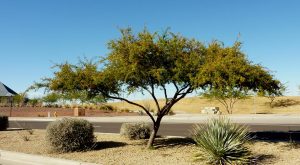by Dr. Jacqueline A. Soule
Our beloved sweet acacia, once know to us as Acacia farnesiana, is now considered Vachellia farnesiana. Why change a perfectly good name?! Some things are just the nature of the beast. Taxonomists change names. Highway engineers build roads. Politicians … well, I won’t go there.
I agree, it is frustrating to try to keep up with changes in scientific names, especially when a plant has been used for years in the trade, and all our reference material has the old names. Taxonomists have their reasons, and I have to admit that there is more than a tad bit of politics involved in this particular name change back in 2005 — but again, I won’t go there. No matter what the name, the blooms of sweet acacia still smell quite sweet.
From the perspective of a person trying to grow or spec a sweet acacia plant for a landscape, the one thing you do need to know is that the name “sweet acacia” was once applied to a number of different species. These species got lumped into one species, but there are most certainly some very different germplasm of sweet acacia out there. These various former species have anywhere from a moderate to a fast growth rate and may reach heights of 15 or maybe 30 feet, with bloom time sometime from February to July – all depending on genetics. Caution – the cold tolerance also varies!
Formerly there were three species, Acacia farnesiana, Acacia smallii and Acacia minuta, but then they were lumped into one, Acacia farnesiana. This may be a mistake because here in Tucson at least, there is a notable difference in cold-hardiness, bloom time and growth habit.
The most cold toler

Sweet acacia is a great choice for desert landscapes, no matter what you call it. Photo courtesy: Arizona State University.
ant (down to 10 F) and earliest blooming plants were once known as Acacia smallii and may come into the trade from “back East” where the species was first collected by Small in what is now Georgia. Blooming in early March in our area, this plant stays mostly low and shrubby, and can be trained up into a somewhat tree-like form.
Acacia minuta comes to our area possibly from the Edwards Plateau of Texas, it tends to bloom a tad later (April) and be a tad less cold tolerant (tip burn at 18 F) than Acacia smallii It tends to get taller, and also suckers more prolifically than the first species.・
Acacia farnesiana is most the tropical, and may experience tip die-back below 25 F. It blooms latest of all, often in June, and is easiest to trim into a tall tree, often reaching 25 feet.
Just to confuse matters further, if you go back a few decades, the gum arabic tree, Acacia nilotica, was sold for a number of years as sweet acacia. Native to the lands around the Nile River, it looks much like the other sweet acacias, and smells similar as well! It was brought into our area back when there was a push to plant desert plants and many Mediterranean plants were imported due to our supposed similar climate (an incorrect assumption, here in the Southwest we get much hotter and less humid). This may be the least cold tolerant species.
So how do you know which “sweet acacia” you are getting? Ask your nursery about their seed source, or if they are growing from cuttings, ask about the parent tree. Find out what temperature range the plants have experienced. Look at the plant — is it already shrubby, or is more tree-like? Most importantly, if you are planting many plants, say in a commercial area, try to get plants from the same source.
If you find yourself dealing with people that wonder why their sweet acacia is so bushy while their neighbor has an elegant tree, this is your opportunity to help educate the public. My advice is to skip the taxonomy! Explain that plants are like people: two children from the same parents can be very different from each other, let alone two children from different parents! Put in human perspective, most of the public can better understand plants.
Dr. Jacqueline A. Soule’ latest book is due out this summer, “Month by Month Gardening in Arizona, Nevada, and New Mexico” (Cool Springs Press). Jacqueline currently lives, teaches and writes in Tucson, AZ, where she also serves as chair of the Advisory Board of the Desert Legume Program. She will be a speaker at Desert Green XX this fall – October 20, 21, 2016, to be held at Texas Station in North Las Vegas, NV. For more information, visit www.desert-green.org.
